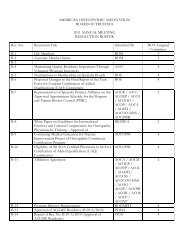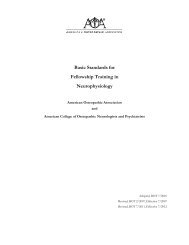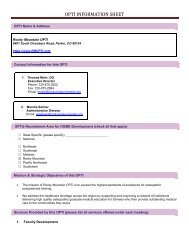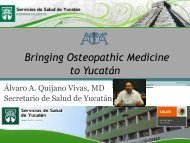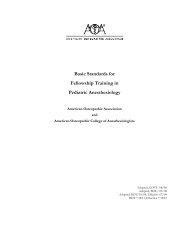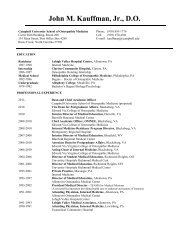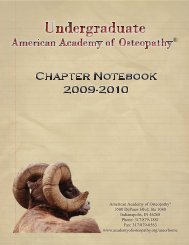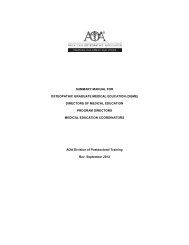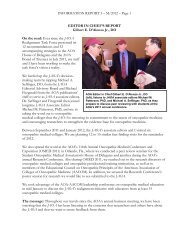Dialogue and Diagnosis - American Osteopathic Association
Dialogue and Diagnosis - American Osteopathic Association
Dialogue and Diagnosis - American Osteopathic Association
You also want an ePaper? Increase the reach of your titles
YUMPU automatically turns print PDFs into web optimized ePapers that Google loves.
InsideOut<br />
(continued from inside front cover)<br />
cent studies have supported the use of<br />
insulin as the first treatment for<br />
patients with T2DM. In addition, the<br />
mantra “once on insulin always on insulin”<br />
no longer seems to be the case.<br />
Many patients only intermittently<br />
need insulin, during acute illnesses or<br />
periods of hyperglycemia.<br />
The glucagon-like peptide-1 (GLP-1)<br />
receptor agonists—injectable incretinbased<br />
medications—have dramatically<br />
changed the acceptability of injection<br />
therapy. These agents, as is explained<br />
in the present supplement, address crucial<br />
issues in diabetes care <strong>and</strong> can improve<br />
both fasting plasma <strong>and</strong> post -<br />
pr<strong>and</strong>ial glucose levels. Unlike many<br />
other antidiabetic medications, GLP-1<br />
receptor agonists are associated with<br />
weight loss. This promise of weight loss<br />
has appeared to help many patients<br />
“overcome” their fear of needles.<br />
The <strong>American</strong> Diabetes <strong>Association</strong>/<br />
European <strong>Association</strong> for the Study of<br />
Diabetes 9 <strong>and</strong> <strong>American</strong> <strong>Association</strong> of<br />
Clinical Endocrinologists 10 have updated<br />
their treatment recommendations<br />
to better reflect the variety of available<br />
treat ment options. Current treatment<br />
recommendations underscore the need<br />
for lifestyle change <strong>and</strong> the use of pharmacologic<br />
treatment at the time of<br />
diagnosis. The recommendations also<br />
emphasize efforts to achieve the lowest<br />
possible HgA 1c level without unacceptable<br />
hypoglycemia. In recognition of<br />
the progressive, multifactorial nature of<br />
diabetes mellitus, 11 recent treatment<br />
recommendations emphasize the use<br />
of combination therapy with agents<br />
that have complementary mechanisms<br />
of action.<br />
This comprehensive approach to<br />
diabetes management is based on evidence<br />
that typical glycemic-control parameters,<br />
such as HgA 1c level, fasting<br />
plasma <strong>and</strong> postpr<strong>and</strong>ial glucose excursions,<br />
<strong>and</strong> hypoglycemia, have an impact<br />
on cardiovascular disease risk,<br />
<strong>Dialogue</strong> <strong>and</strong> <strong>Diagnosis</strong> // September 2012<br />
mortality, quality of life, <strong>and</strong> clinical<br />
outcomes in individuals with diabetes<br />
mellitus. 9<br />
The present issue of <strong>Dialogue</strong> <strong>and</strong><br />
<strong>Diagnosis</strong> provides practical strategies<br />
for introducing <strong>and</strong> adjusting<br />
injectable treatments in patients with<br />
diabetes mellitus <strong>and</strong> for improving patient<br />
acceptance <strong>and</strong> adherence. Joseph<br />
M. Tibaldi, MD, describes the “how<br />
<strong>and</strong> when” of introducing insulin for a<br />
patient whose T2DM has progressed.<br />
His case report also highlights factors<br />
that are indicative of patients with<br />
atypical forms of diabetes mellitus.<br />
These atypical forms may represent as<br />
much as 10% of diabetes cases.<br />
Jeffrey S. Freeman, DO, reviews the<br />
new treatment algorithms for diabetes<br />
mellitus, <strong>and</strong> he discusses the risks <strong>and</strong><br />
benefits of oral <strong>and</strong> injectable treat -<br />
ments. He uses a case report to show<br />
how a physician can decide on the progression<br />
of treatment on the basis of<br />
patient wishes while addressing both<br />
glycemic <strong>and</strong> nonglycemic effects.<br />
James R. LaSalle, DO, discusses the role<br />
of the incretin-based agents in treating<br />
patients with advanced diabetes mellitus.<br />
He presents data supportive of the<br />
use of incretin-based agents for patients<br />
who are already taking insulin.<br />
We hope that this monograph will<br />
help the reader better underst<strong>and</strong> the<br />
application of both newer <strong>and</strong> older<br />
treatments for patients with diabetes<br />
mellitus throughout the full spectrum<br />
of disease. The reader should gain an<br />
appreciation of the nonglycemic benefits<br />
of treatment <strong>and</strong> be better able to<br />
use a shared medical-decision<br />
approach in the care of patients with<br />
T2DM.<br />
References<br />
1. Centers for Disease Control <strong>and</strong> Prevention.<br />
National Diabetes Fact Sheet: National Estimates<br />
<strong>and</strong> General Information on Diabetes <strong>and</strong><br />
Prediabetes in the United States, 2011. Atlanta,<br />
GA: US Department of Health <strong>and</strong> Human<br />
Services, Centers for Disease Control <strong>and</strong><br />
Prevention; 2011.<br />
2. Rowley WR, Bezold C. Creating public<br />
awareness: state 2025 diabetes forecasts<br />
[published online ahead of print January 27,<br />
2012]. Popul Health Manag. 2012;15(4):194-200.<br />
3. Zafar A, Davies M, Azhar A, Khunti K. Clinical<br />
inertia in management of T2DM [published<br />
online ahead of print August 16, 2010]. Prim<br />
Care Diabetes. 2010;4(4):203-207.<br />
4. Ziemer DC, Miller CD, Rhee MK, et al. Clinical<br />
inertia contributes to poor diabetes control in a<br />
primary care setting. Diabetes Educ.<br />
2005;31(4):564-571.<br />
5. Peyrot M, Rubin RR, Lauritzen T, et al;<br />
International DAWN Advisory Panel. Resistance<br />
to insulin therapy among patients <strong>and</strong> providers:<br />
results of the cross-national Diabetes Attitudes,<br />
Wishes, <strong>and</strong> Needs (DAWN) study. Diabetes Care.<br />
2005;28(11):2673-2679.<br />
6. Grant RW, Wexler DJ, Watson AJ, et al. How<br />
doctors choose medications to treat type 2<br />
diabetes: a national survey of specialists <strong>and</strong><br />
academic generalists [published online ahead of<br />
print March 2, 2007]. Diabetes Care.<br />
2007;30(6):1448-1453.<br />
7. Grant RW, Lutfey KE, Gerstenberger E, Link<br />
CL, Marceau LD, McKinlay JB. The decision to<br />
intensify therapy in patients with type 2<br />
diabetes: results from an experiment using a<br />
clinical case vignette. J Am Board Fam Med.<br />
2009;22(5):513-520.<br />
8. Nakar S, Yitzhaki G, Rosenberg R, Vinker S.<br />
Transition to insulin in Type 2 diabetes: family<br />
physicians’ misconception of patients’ fears<br />
contributes to existing barriers. J Diabetes<br />
Complications. 2007:21(4);220-226.<br />
9. H<strong>and</strong>elsman Y, Mechanick JI, Blonde L, et al;<br />
AACE Task Force for Developing Diabetes<br />
Comprehensive Care Plan. <strong>American</strong> <strong>Association</strong><br />
of Clinical Endocrinologists Medical Guidelines<br />
for Clinical Practice for developing a diabetes<br />
mellitus comprehensive care plan. Endocr Pract.<br />
2011;17 suppl 2:1-53.<br />
10. <strong>American</strong> Diabetes <strong>Association</strong>. St<strong>and</strong>ards of<br />
medical care in diabetes-2012. Diabetes Care.<br />
2012;35 suppl 1:S11-S63.<br />
11. Defronzo RA. Banting Lecture. From the<br />
triumvirate to the ominous octet: a new<br />
paradigm for the treatment of type 2 diabetes<br />
D&D<br />
mellitus. Diabetes. 2009;58(4):773-795.<br />
Jay H. Shubrook Jr., DO, is an associate<br />
professor of family medicine <strong>and</strong> a<br />
diabetologist. He serves as the director<br />
of clinical research <strong>and</strong> director of the<br />
Diabetes Fellowship at Ohio University<br />
Heritage College of <strong>Osteopathic</strong><br />
Medicine. He is a Fellow of the<br />
<strong>American</strong> College of <strong>Osteopathic</strong> Family<br />
Physicians. He can be reached at<br />
shubrook@ohio.edu.<br />
33



